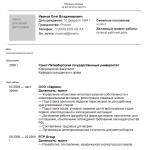Uranium dishes of the USSR. The dangerous magic of uranium glass. Uranium Glass Items: Mass Production
Uranium glassware- collectible and increasingly gaining popularity.
Based on various articles and discussions, I am making a short convoy to help the novice glass collector in general and uranium glass in particular.
A little about harm uranium glass rumors about which are greatly exaggerated.
The proportion of uranium oxide added to glass BEFORE SELTING ranges from 0.3% to 4-6%, i.e. it is harmful in the process of its production.
Well, in order to suffer from the radiation emitted by uranium glass, you need to drink daily from a glass of uranium glass three times a day for 4 thousand years.
Lyudmila Gurchenko had a huge collection of uranium glass, but this somehow did not affect her health.
How to check uranium glass or not at home and not very conditions:
1 way. under a UV lamp with a dark bulb and a spectrum from 350 nanometers to 470 nanometers: uranium glass fluoresces if not, then 2 way
2 way. I check with a dosimeter-radiometer MKS-03sa with fresh verification, if it does not show a beautiful figure and differs little from the photo, then method 3
3 way. at work, I put it under a scintillation detector, though it’s very old, the gamma range is much wider, and if the glass is contaminated with lead, then it will still show the excess of the radiation level over the natural background by several times. Well, from the latter, if all other ways to recognize glass do not work, there are no questions for an X-ray luminescent analyzer. True, recently the pipe has been standing with a soft anode, and I don’t want to change it for another one and then return it back.
Uranium glass or not, you can only tell by highlighting it with ultraviolet light.
Someone is trying to check just by highlighting the screen mobile phone. I tried - it doesn't work.
But if you take a picture in complete darkness with a flash, then the difference is visible.
As for the color of uranium glass, its color ranges from barely green, mustard, dark green to turquoise and even blue.
This basket is a great example, also uranium.

But this mug is just beautiful green glass. By the way, it is also collected. But that's a completely different story.

green glass mug
About the danger: uranium glass emits only slow electrons and their range in the air is no more than thirty centimeters, and if you admire the glass from half a meter, then no more than twenty-five hours a day and is pressed against glass for no more than a couple of hours a day. A couple of hours is enough to wipe clean and use glass objects.
For a simple layman, if uranium glass does not fluoresce, then interest in it somehow disappears ....
At concentrations of uranium salts above about or twelve percent or so, the fluorescence disappears to zero as the concentration increases and can only be checked with a dosimeter. Or the glass melt is doped with lead, then ultraviolet does not penetrate into the glass and it does not glow, or additionally some kind of additive, I don’t remember the effect, similar glass does not fluoresce.
Checking with ultraviolet when there is no dosimeter at hand: glowing - uranium, off - not uranium. But in this case, non-luminous uranium glass cannot be determined.
A dosimeter is a useful thing sometimes to check collections. When uranium glass is irradiated with x-rays, it then spits soft x-rays for up to several weeks, or some ill-wisher irradiates with neutrons, so the background of uranium glass jumps sharply, and not only electrons fly, but the most unpleasant gamma appears.
So it's up to you whether or not to collect such a beautiful and slightly extreme uranium glass.
(This article, as well as a lot of interesting things about radiation on my website: http://www.radiation-around.ru/).
Surely, many of you have recently heard (or read) the phrase "Uranium glass", without even suspecting that repeatedly faced and (or) continue to face this in everyday life. Very
an insidious phrase, however, like the word "Uranus" itself. For some, this word will cause associations with
The 7th planet of our solar system, someone with the ancient Greek god of the sky, and someone with metal
actinide with serial number 92 in periodic table Mendeleev. The topic considered below will be
closer to those whose associations are connected specifically with metal, and is interesting to everyone without exception (I hope :)).
To the question "what properties does the metal "Uranium" have, the vast majority will answer "radioactivity".
And not in vain, because this is its main property, for which humanity has been digging for almost a century
huge pits and many kilometers of mines in earth's surface in search of this treasured metal.
Knowledgeable people, of course, will object now, adding that metal alloys with uranium impurities have
incredible strength that they are used to create durable armor and armor-piercing shells, etc. etc.
But that would be a digression from the topic. But there is another remarkable property of uranium, which manifests itself,
when it is added as an impurity. For example, if you add uranium to glass (approximately 3% of the total mass of glass),
then it will acquire a beautiful greenish tint. And if this glass is also exposed to ultraviolet radiation,
then it will begin to emit a bright acid-green light. 
photo: website flyback.org.ru, user Alhim 
photo: site fotkidepo.ru, user A-Guru
Solutions containing uranium (uranyls), uranium salts, minerals, etc. have the same properties. If you
get into an old abandoned mine, where uranium used to be mined, and shine on its vaults with an ultraviolet flashlight, you will see a huge number of luminous bizarre veins - patterns of acid green color. However, I don'tI would recommend that you climb into such mines, despite the fact that there are enough of them left in our wonderland with
times of the USSR.
You are probably thinking now, they say, but in what way does this concern us? After all, uranium glass is something so
exotic, specific, and it is unlikely that a mere mortal will be "lucky" to encounter him in this life.
But what if I say now that right behind you is a huge piece of this very uranium glass?
For example, in a sideboard, among the huge amount of crystal that you so diligently hoarded in Soviet times?
That green vase over there: 
Not? Well then, maybe that clock in the green glass counter? 
Not again? Then the handle on that old wooden door that you haven't changed yet? 
photo: forum.rhbz.ru, user Lexis
Or that same green ashtray that you inherited from your father?

Or salt shakers on the kitchen table? 
And if those very green or turquoise buttons are made of a material that was once incomprehensible to you, similar to glass?

photo: site rus-sur.ru, user 2011
Another name for uranium glass, which was previously used everywhere, is "Royal glass". Between two
you can put an equal sign with these names, and you will not be mistaken. The same royal glass from which the Soviet
times riveted a huge number of "artifacts", in most cases useless, performing purely decorative
functions. Previously, if you had a vase of royal glass in your sideboard, then you lived in abundance.
Now on the Internet you can find a large amount of old rubbish from uranium glass on various trading floors.
right away that the prices bite a little, and for this reason I still haven’t got something like that myself :) But something for me
still got my hands on it. These are the so-called "cabochons" - glass pieces for decorating various unaesthetic household items, to create all sorts of mazek and other things.
they are under ultraviolet 
Similar can be found in stores of various glass products. The main advantage of these glass pieces over others
types of glass, according to the manufacturer, is the very ability to luminesce under ultraviolet light. Honestly, I have a hard time imagining any room with ultraviolet lighting. Is it some kind of medical room in whichcarry out quartzing, but at such moments people, as a rule, are not in the room. Anyway.
Let's move on from covering this problem "in breadth" and move on to lighting "in depth": what is uranium glass and what it is eaten with.
Uranium glass is a mixture of borosilicate glass with uranium-238 oxide (usually). When the ratio of the mass of glass and uranium
1.5% glass has a yellow tint. At a mass ratio of 3%, the glass acquires green color. When adding more the amount of uranium, the glass does not change its shade, but only loses transparency and the ability to luminesce in UV radiation, andradioactivity is only growing, so it makes sense to vary the percentage of uranium within 0 ... 3% of the total mass of glass.Depleted uranium oxides (U238 isotopes) are mainly used. This isotope is the most stable, so products fromuranium glass are weak sources of alpha radiation. Over time, U238 decays, and in glassdaughter decay products with shorter half-lives accumulate. As a result, the radioactivity of uranium glassgrows and other types of radiation (betta, gamma) appear.
The radioactivity of royal glass products varies from about 20 to 1500 μR / h in total for alpha, beta and gamma, and the maximum safe background level established by the authorized bodies is 30 μR / h (what types of radiation andI won’t explain why they are dangerous, there is enough information on the Internet). It depends on factors such as theuranium isotope, percentage of uranium oxide, type of glass, product size, and even oxide distribution uniformityby volume of glassware. That bunch of glass pieces that fell into my hands emits 830 μR / h in total in beta and gamma.This is about 28 times higher than the maximum safe level of radiation. Alpha, unfortunately, is not possible to measure.And if my radiometer were also sensitive to alpha, then the readings would be higher than 1000 μR / h.

1 µSv/h=100 µR/h; 8.36 µSv/h=836 µR/h
If you have never been a little more interested in radiation than a layman, then you may be a little scared.above the figures described, they say, how is it ??? 30 times the maximum allowable radiation level! But no, this level of radiationthere is no need to be particularly afraid. First, in order to get radiation sickness from uranium glass, you must be exposed to it.radiation for several years continuously. Secondly, the radiation power is inversely proportional to the distance fromsource. And if you have such a vase somewhere in the sideboard, or you use a salt shaker or an ashtray from time to time,then you have nothing to fear. You do more harm by smoking cigarettes or having x-rays every six months.
Handling uranium glass is also not dangerous, because the combination of uranium and glass is very strong. No wonder it's highly radioactive. waste is often stored in glass.
Therefore, if you do not keep a uranium glass salad bowl under your pillow or do notif you carry a piece of "uranium" in your trouser pocket, then there is absolutely nothing to be afraid of, and you should not rush to throw out the green vase.May she continue to please the eye. Well, if you are an inveterate radiophobe, then do not forget that there are a lot of people on the Internet,who want to buy this artifact, and for pretty good money.
In conclusion, I would like to say about some BUT:
1. Not all green glass is uranium. There are various types of glass that are given a green and yellow tint by adding other non-radioactive impurities. The most reliable way to find out if this glass is uranium or not is to measure its radioactivity. If there is no dosimeter, then shine a UV flashlight on it, it should glow brightly with an acid green light. In principle, you can even use a purple flashlight, as, for example, in some lighters or fountain pens, but this will not give a 100% guarantee.
2. There are established thresholds for the absorbed dose at which a person receives one or another degree of radiation sickness. But We must not forget that it depends on the characteristics of the body of each person. Someone stay healthy after spending a week insidethe fourth power unit of the Chernobyl nuclear power plant, and for some, a short contact with uranium glass is enough, so it cannot be argued thatthat it is safe, even if you are not physically in contact with it, but only occasionally are nearby.
µR/h. The more visits to this page, the higher the radioactivity of uranium glass :)
Every hostess cares about the beauty and comfort of her home. Very often, women purchase this or that product, only focusing on its appearance, without even thinking about what it is made of and what its origin is. The beautiful and unusual type of glass known as uranium glass is as beautiful as it is interesting in its origin.
What is uranium?
Uranium is a substance with unusual properties. It has tremendous power, which is actively used by man in various areas of life. Appearance of this unusual substance does not differ from silver, but its weight is much greater. A small piece can weigh up to half a ton.
A feature of this material is its radioactivity. Uranium atoms decay in air, and the energy that is released in this case is radiation. Some elements of matter are capable of exploding, dividing into several units. It is thanks to this ability that uranium is used in nuclear stations and for the production of weapons.
The substance is extracted from the ore.uranium orepre-processed. To collect a small amount of material, you have to process a huge mass of ore. From several tons, you can get only a few kilograms of a valuable substance.
After obtaining this compound, it is subjected to additional purification. One kilogram of uranium has enormous energy, comparable to the force of 3 million kg of coal. This feature distinguishes this substance, makes it indispensable at nuclear power plants.
Various names for uranium glass
Glass from uranium ore is a substance whose elements are colored by uranium compounds. Because of this, there is such a thing asuranium glass luminescence. It takes on a slight greenish tint in the dark.Glass has other names, such as canary, Canary, Burmese, depression.

The concept of "canary" and "canary" glass appeared in the 18th century in England.Somewhat later, the concept of "Burmese" glass came into use. It had an opaque structure and was painted in a pale pink or yellowish hue. The glass contained not only uranium elements, but also gold impurities. It was coloring that became the basis for the emergence of a new concept. A piece of Burmese glass was presented to the Queen of England, who compared its color to a sunset in Burma. During the Great Depression, the concept of "depression glass" came into play. It is most popular in America.In the 19th century, a new name "Vaseline glass" or "petroleum jelly" begins to be used here. It had a greenish-yellow color, strongly reminiscent of shades of olive oil. Greener tones shone less and were less valuable. The composition of the product had a high content of iron, which contributed to the change in color and price. In Russiacalled "royal". Its use begins in the 19th century.
Not all countries used a specific name for the uranium product. Some simply called it by the name of the manufacturer. Herewas actively processed and a large number of popular goods were produced from it. So, in Finland, the name of riihimak glass was practiced after the name of the manufacturer.
For a long time, few people could guess about the unusual ability of glass to fluoresce. Such an unexpected feature of the product was discovered only after the start of the mass use of electric lighting.
History of origin and beginning of use
Uranium began to be actively used in ancient times. Evidence of this is the discovery of a mosaic in the house of an Italian local resident, which contained uranium compounds. Somewhat later, in the Middle Ages, uranite mining began in the Czech Republic. Even then, it begins to be used as a coloring matter for creating dishes and mosaics.

The period of active production of uranium products in Russia begins in 1830.uranium glassenjoyed great popularity among buyers, and the production of such goods grew. This time was a period of new experiments. Other compounds and additives were used, experimented with transparency, color and thickness of products. The greatest danger of a radioactive substance has always been precisely for industrial workers who were in direct contact with uranium. Glassblowers in the factories had an increased mortality rate.
Until 1945, the plants used pure uranium, and after the war they began to use depleted uranium in production. This change in technology greatly increased the cost of products.Uranium glass productswere an element of pride and well-being.
The popularity of products with uranium
To date, glass from uranium is produced only at a few factories in the Czech Republic and America, and now the goods are used only as decorative elements. Cutlery is out of use. Uranium glassware has become the subject of collections and pride of their owners.

Prices for such goods are not cheap. You can find products from several tens of dollars to several thousand. One of the famous Russian collectors was Lyudmila Gurchenko, who first saw uranium glass items in the Hermitage. Since then, she has become a fan of these products.
Composition of uranium glass
Popular and beautiful uranium glasses could be created due to a certain composition. They had to contain elements such as potassium, boron, zinc. A sufficient addition of potassium and boron gave such an unusual glow. Ordinary lead glass did not have such a beautiful effect due to the absorption of sunlight. Lead compounds could also be used for uranium glasses, but the beautiful glow disappeared. So, to color the composition yellow and create a stone similar to topaz, uranium was added. To give the stone the necessary noble shade, it was necessary to add a significant amount of uranium, with an overabundance of which the glow disappeared.
Primary colors
There are several colors of uranium:
1. Yellow.
2. Dark green.
3. Orange.
4. Brown.
Uranium compounds were not always used to create a yellow or yellow-green hue of the composition. It could be: flour, starch and other additives. Uranium gave the product exactly a fluorescent shade, which distinguished it from other additives. and make the product unique.

Standard uranium glass had a specific composition and creation rules:
1. Optical glass with a yellow tint using boron and ZhS 19 silicate - 1.37% UO 3 through uranyl nitrate UO 2 (NO 3) 6H 2 O.
2. Optical glass with a green tint using zinc and phosphate ZS 7 - 2.80% UO 3 through sodium uranit Na 2 UO 4 .
Manufacturers always accompany quality goods with a passport. Here the composition of the product and its features are noted, including the percentage of certain compounds.
Peculiarities
A feature of products with the addition of uranium is the presence of a luminescent glow. It is created due to the high refraction of sunlight. Products accumulate sunlight, which is converted into a greenish-yellow glow. This feature distinguishesand other products from simple products colored with other substances (for example, cerium).
Radioactive properties of products
Uranium has a certain level of radioactivity, in view of this, the question often began to arise about whether. The answer to this depends on several factors:
1. The percentage of uranium in the product.
2. His origin.
3. isotopic composition.
4. The age of the item.
The most dangerous are products made many centuries ago. They contained enough uranium to speak of its effect on others. Later products contained less of the hazardous substance.Uranium glass gobletwith the addition of a 6% substance has gamma radiation that does not exceed the permitted limits. Despite this, beta radiation can significantly exceed the permissible levels. To avoid its activity, products with the addition of uranium are recommended to be stored behind glass (for example, in sideboards or cabinets). It perfectly prevents negative radiation.

Uranium glass, compositionwhich is radioactive is not recommended for food use. Radioactive elements, when ingested, adversely affect its work and metabolism. Even when using uranium purified from impurities, the radioactivity of which becomes minimal, over time the product increases its hazard factor. This happens because of the decay products. When exposed to oxygen, the process of fission of chemical elements occurs and radiation is released. Despite this, cases of poisoning by uranium radiation when eating food from such dishes have not been recorded. It is only noted that the mortality of glassblowers who create products from uranium glass has always been above average.
How dangerous is the use of such products
To date, the production of uranium glass has been reduced to a minimum, and the statistics of its impact on the human body have been studied little. However, we can say that using a set of dishes with a luminescent glow as a souvenir is not dangerous. Periodic washing of glasses will also not affect the health and well-being of the owner of the collection. Similarly, it is safe to use crystal glassware, which is so rich in lead.
Methods of irradiation when using products with uranium
There are several options for possible exposure when using uranium glassware:
1. Impact on the human body of gamma rays.
2. Irradiation of human hands with beta particles.
3. Ingestion of the substance in food when using dishes made of uranium.
A study was conducted that showed that the workers involved in the procedure for delivering products from the factory to the point of sale are exposed to maximum radiation.

Conclusion
So beautifulno wonder it has fallen out of everyday use. Fans of unusual souvenirs are advised to store such products in glass sideboards and not use them for eating.
The word "uranium" modern man causes nervous tremors. It is primarily associated with radiation and death. Someone else remember about the energy, but still then go Atom stations, accidents, waste, again radiation and ... But it turns out that uranium is capable of not only bringing danger, but also giving beauty.
Uranium glass is glass that has been tinted with uranium oxide in colors ranging from transparent yellow to deep yellow-green, turquoise, and even blue. But this glass is not only distinguished by its color. Its main difference is that uranium glass intensely fluoresces - it burns in ultraviolet rays. Are uranium products hazardous to human life and health? Let's find out.
All this happens due to the addition of uranium oxide to the glass before melting. Its content in glass ranges from 0.3% to 4-6%, although some objects of the 19th century contain even up to 25% uranium. Interestingly, with an increased content of uranium salts, fluorescence gradually weakens and completely disappears when the content of uranium salts is more than 20% of the total glass mass.

This is how Lyudmila Markovna Gurchenko talked about her first meeting in it ... Once in the Hermitage, where I went every Saturday and Sunday, when I was filming in Leningrad, I saw a transparent green vase! The sun was shining brightly, this vase of amazing beauty stood on a cabinet made of Karelian birch. Words cannot convey! Then I found out that it was uranium glass, which was no longer produced in Russia at the beginning of the 20th century, because glassblowers were dying from uranium fumes. I, while still studying at the institute, began to walk on consignment shops buy vases. Now I have three windows - all in uranium glass! Sun, Karelian birch, green vase and pink flower!


A feature of uranium glass is fluorescence, which lies in the fact that uranium glass, by absorbing ultraviolet and violet rays, transfers part of the absorbed energy to the region of the green radiation spectrum. For practice, it is very important that this secondary, green radiation does not continue the path of the previous beam, but is scattered.
Uranium glass is silicate, for which calcium, zinc and barite compositions are recommended and preferably high in potassium and boric anhydride, this provides more intense glass fluorescence. The lead content in the glass does not give fluorescence, but mixed lead-barium-zinc glasses fluoresce. The content of uranium should be relatively large 0.3-1.5%, since the coloring ability of uranium is small, in some cases 4-6% uranium is introduced, however, with a higher content of uranium in the glass, the fluorescence gradually weakens.
Uranium is introduced into the charge in the form of yellow sodium uranium Na2UO4, or mixed oxide U3O8=UO2*2UO3 of dark green color, other uranium oxides of orange color UO3 or brown color UO2.

Well, if you understand from a scientific point of view, then we can talk about two risk factors - radioactive exposure and chemical toxicity of uranium glass
No doubt radioactive, but due to its long half-life (4.5 billion years), and only the alpha activity of its radio emission, the radiation hazard of uranium glass is very negligible. In addition, it must be taken into account that such glass can emit radiation only on its surface and the range of these radioactive particles is no more than 10-15 cm. Therefore, storing uranium glass in a residential area does not pose a risk of exposure to residents. Accordingly, if you admire your collection glass from a distance of half a meter and devote no more than 2 hours a day to cleaning it, then you have practically no chance of getting even a minimal dose of radiation!

As for the chemical toxicity of uranium, in this respect, the uranium contained in the glass does not pose any danger, just as the lead contained in large quantities (tens of percent) in all crystal products does not pose a danger. But crystal glassware is used everywhere and much more often than uranium glassware. The isolation of radon with uranium glass has not been experimentally confirmed, but even if this would happen, the effect of radon on the body in such insignificant quantities is not considered as something super-harmful.
Lyudmila Gurchenko lived a long and fruitful life surrounded by her huge collection - one of the best evidence of this.

And now a little about the history of uranium glass.
The appearance of uranium glass is estimated at least 79 BC. BC, which date a mosaic found in a Roman villa at Cape Posillipo in the Gulf of Naples (Italy) in 1912 and containing yellow glass with 1% uranium oxide. Since the end of the Middle Ages pitchblende (uranite) began to be mined from the silver mines of the Habsburgs near the city of St. Joachimstal in Bohemia (now Jachymov, Czech Republic) and was used as a dye in local glass production.
The beginning of the mass production of uranium glass products took place already in the Late Middle Ages, after the discovery of uranium-containing compounds in the silver mines of the Habsburgs in Joachimsthal (Bohemia).

The first industrial production of uranium glass began in the 1830s at the I. Riedel manufactory in Unter Polau, Bohemia. Josef Riedel named the main colors of uranium glass after his wife Anna: -Grun) - Annagryn.

At the Riedel manufactory, traditional for that time blown vases, glasses and glasses, decorated with engraving, were made from uranium glass.
In the 40s of the nineteenth century, the production of uranium glass began everywhere, including in Russia. Each manufacturer made its own changes to the glass formulation. The color and shades of uranium glass ranged from mustard to white, turquoise and blue. We also experimented with the transparency of glass. Translucent glass was called vaseline, opaque green - chrysoprase or jade
The largest number of uranium glass products falls on the period of Art Nouveau and Art Deco, that is, in the 1880s-1930s. One of the largest glass manufacturers at that time was the famous English firms BAGLEY and DAVIDSON. They diversified the finishing of glass products by frosting with hydrofluoric acid, diamond carving, as in cutting crystal, combined uranium glass with other types of glass in one product, decorated it with engraving and etching. Manufacturers experimented with new glass additives - mostly large amounts of iron oxides - to achieve new colors and effects.
But at all times, the main danger of uranium glass was precisely in its production. Contact with uranium oxides caused great harm to the health of glassblowers both in the era of handicraft production, and later, when the leading manufactories switched to the production of uranium glass in industrial scale pressing method. But all this is already in the past. During the Second World War, the production of uranium glass was stopped forever.

Currently, uranium glass is practically not produced and is an antique and collectible value. The cost of uranium glass products is affected, as well as all antiques in general, by a number of factors - time of manufacture, complexity, beauty, manufacturer's name and rarity in the market. The cost of products ranges from several tens of dollars to thousands and more. The unusualness of uranium glass will never become boring to its owner and every time it will remind you of the carefree era between the two world wars - when people were in a hurry to live and enjoyed every minute.
And even though you will not always admire your uranium glass in the dark with special lighting, this will not prevent you from feeling like the owner of a unique and rare item from a bygone era.

However, it is still worth recalling that since uranium is radioactive, uranium glass is, to one degree or another, a source of radiation hazard. It depends on the content of uranium, its origin and isotopic composition, and the age of the item. The maximum danger is presented by products made with the addition of natural uranium minerals, in which the latter is in secular equilibrium with its decay products. If chemically pure uranium is used, purified from daughter decay products, then the product is initially only a weak source of alpha rays, but over time, decay products accumulate in it, which eventually leads to a significant increase in radioactivity. The safest addition is depleted uranium.





It's no secret that you can create amazing, beautiful things from glass that complement your interior or for use in everyday life. Without it, we simply cannot imagine our existence. But some types of glass contain certain substances in their composition, endowing it with unusual properties, such as luminescence.
3452 1 2 5
Before you are products made of uranium or vaseline glass. The unusual "vaseline" name of the glass was due to its creamy tint, but it is "uranium" because it really contains the same uranium, known to everyone as a source of deadly radioactive radiation. Uranium glass can be of different colors: yellow-green, emerald and brown, while the shades and saturation vary. Glass makers achieve such a color result using salts and uranium oxides in their work.

The main difference between uranium glass and ordinary glass is its color shade, as well as a bright yellow-green glow from ultraviolet rays. Although it should be noted that if the composition of the glass contains more than 20% uranium, the ability to glow is lost. The authenticity of such glass can only be determined by the emitted ionizing radiation, which can be measured by a special device - a dosimeter. With a mass fraction of uranium up to 6%, the products give gamma radiation, slightly higher than the natural background, and beta radiation, which exceeds the norm by dozens of times.

Based on this, a completely logical question arises - is this glass dangerous for health? The danger of glass directly depends on the origin, composition and age of the product. A detailed analysis of the radiation exposure of uranium dishes was carried out by the Nuclear Regulatory Commission. There are three routes of exposure to radiation associated with Vaseline glass:
- body exposure to gamma rays emitted by uranium radionuclides;
- the effect of beta particles on the skin of the hands;
- absorption of uranium leached by food in contact with glass.

Although uranium glassware emits ionizing radiation comparable to natural background radiation readings, experts do not recommend storing uranium glassware together or placing it behind glass cabinet doors that trap beta radiation.
And of course, you can not use such dishes for food purposes, since uranium is able to leach out of glass and enter the body with food. Studies conducted during the day showed that the leaching of uranium by water is minimal, and by acetic acid - 30 µg/l. Given that it is toxic and binds to proteins, disrupting their function, and inhibits the activity of enzymes, primarily affecting the kidneys, it is categorically not recommended to use such dishes for their intended purpose.
Now products from uranium glass are not produced. The peak of production of such products fell on the period from 1920 to 1940, during which time over 260 tons of uranium dyes were produced, half of which went to the production of various products: jewelry, dishes, tiles, buttons, household items and decor. Production ceased with the outbreak of World War II, as all uranium stocks were confiscated for the war effort. At the end of hostilities, production resumed, but was switched to depleted uranium, which contains less uranium-235 and is 2-3 less active than natural uranium compounds.





